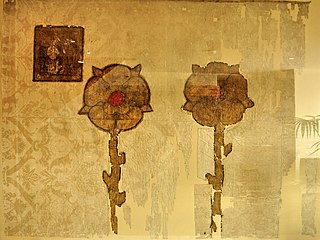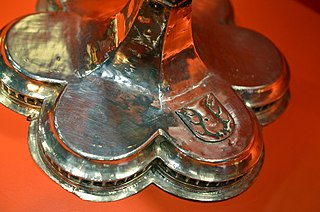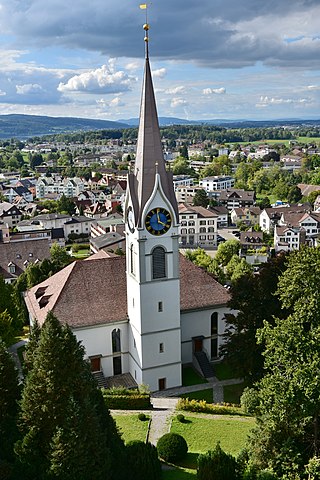
The von Glarus is an old Swiss family of lower nobility (Knights) from Glarus in Switzerland.

The von Glarus is an old Swiss family of lower nobility (Knights) from Glarus in Switzerland.
The family can be traced back to the 9th century. Until 1240 it was still found in the Castle of Sola in Glarus. In the middle of the 13th century it was first mentioned in Zurich. For more than three generations members of the family sat in the city council as knights of Glarus. The family went into two directions. The founders were Heinrich (first mentioned 1246) and his nephew Rudolf Ist (first mentioned 1250). They were vassals of the monastery of Fraumünster and owner of the preys of the church in Höngg above Zurich. Members of the Family married with other nobles, namely with „von Hünenberg“, von Vennen, „von Bürglen“, „von Windegg“, von Wetter-Tegerfelden“, von Landenberg and „von Liebegg“. The Tschudi family origins of the line from Johannes “von Glarus” (1280-1350) and Anna “von Landenberg“. At the same time Jakob married Katharina “von Liebegg“ and inherited the Liebegg Castle. In the year 1275 he was mentioned as Minister of Berchthold of Hallwyl, [1] the local Baron and Sheriff. This line of the Knights of Glarus lost their fortunes and nobility. They became landowners and worked under the name of Glar, Glor, and Gloor as „Untervogt“ (Ministers) of the "von Hallwyl" for several centuries. [2]

The counts of Toggenburg ruled the Toggenburg region of today's canton of St. Gallen, Switzerland, and adjacent areas during the 13th to 15th centuries.

Uster is a town and the capital of the Uster District in the Swiss canton of Zürich.

The Rütli Oath is the legendary oath taken at the foundation of the Old Swiss Confederacy by the representatives of the three founding cantons, Uri, Schwyz and Unterwalden, It is named after the site of the oath taking, the Rütli, a meadow above Lake Uri near Seelisberg. Recorded in Swiss historiography from the 15th century, the oath is notably featured in the 19th century play William Tell by Friedrich Schiller.

The Landenberg family was a noble family in medieval Switzerland.

Friedrich VII, count of Toggenburg, was the last of the Counts of Toggenburg who ruled in what would become Switzerland. His death without heirs or a will led to the Old Zürich War.
Switzerland, officially the Swiss Confederation, is a collection of semi-autonomous cantons. As membership of the confederation has fluctuated throughout history, each of these cantons has its own unique history and nobility. Typically, each canton had its own constitution, currency, jurisdiction, habits, customs, history, and nobility.

The Münch were a Swiss knightly family in the city of Basel and its environs. The first mention of the family dates from 1154; it died out in 1759. In the thirteenth century it was, with the Schaler family, one the most influential families in Basel. From about the end of the fourteenth century members of the family took no further part in the political life of the city.

Marmels Castle German: Burg Marmels is a ruined castle in the municipality of Marmorera in the district of Albula in the canton of Graubünden in Switzerland.

Rüti Monastery was a former Premonstratensian monastery, founded in 1206 and suppressed in 1525 on occasion of the Reformation in Zürich, situated in the municipality of Rüti in the canton of Zürich, Switzerland. The monastery's church was the final resting place of the Counts of Toggenburg, among them Count Friedrich VII and 13 other members of the Toggenburg family, and other noble families. Between 1206 and 1525, the monastery comprised 14 incorporated churches and the owner of extensive lands and estates at 185 localities.

Fracstein Castle is a castle in the municipality of Seewis im Prättigau of the Canton of Graubünden in Switzerland. It is a Swiss heritage site of national significance.

The Grünenberg family was a medieval Swiss noble family. The family was active from the middle of the 12th century until the 15th century in the Swiss Plateau, mostly in the Bernese Oberaargau. There were two major branches, the Grimme and Schnabel lines which then further divided into other branches. Some of these branches owned land in Alsace and in southern Bavaria, especially in the Markgräflerland and in Breisgau. About one hundred members of the family are known today. The family name comes from Grünenberg Castle in Melchnau in the Canton of Bern.

The House of Rapperswil respectively Counts of Rapperswil ruled the upper Zürichsee and Seedamm region around Rapperswil and parts of, as of today, Swiss cantons of St. Gallen, Glarus, Zürich and Graubünden when their influence was most extensive around the 1200s until the 1290s. They acted also as Vogt of the most influential Einsiedeln Abbey in the 12th and 13th century, and at least three abbots of Einsiedeln were members of Rapperswil family.

Elisabeth von Rapperswil was the last countess of the House of Rapperswil, and secured by her second marriage the female line of the Counts of Rapperswil and the extensive possessions of Rapperswil in the former Zürichgau to the Laufenburg line. Her son by first marriage was Reichsvogt Wernher von Homberg, and her oldest son by second marriage was Count Johann von Habsburg-Laufenburg who passed over the title of the count of Rapperswil to his oldest son Johann II and his brothers Rudolf and Gotfried.

The Ruins of Radegg are the ruins of a spur castle built around the year 1200 in the Canton of Schaffhausen, Switzerland and destroyed around the year 1300. It is located high above the Wangental on a spur of the Rossberg which drops off steeply on three sides in Osterfingen in the municipality of Wilchingen.

Elisabeth von Matsch was the last countess of the Swiss noble House of Toggenburg from 1436. She was the spouse of Friedrich VII, count of Toggenburg.

Johann II von Habsburg-Laufenburg was the Count of Habsburg-Laufenburg and later Count of the House of Rapperswil.
The Regensberg family was a family of counts from the Canton of Zürich in Switzerland. They had possessions in the medieval Zürichgau from the probably mid-11th century and became extinct in 1331 AD. With the extinction of the male line, the city republic of Zürich laid claim to the Regensberg lands and formed the Herrschaft Regensberg respectively Äussere Vogtei.

Alt-Regensberg Castle is a hill castle which was built about the mid-11th century AD by the House of Regensberg in the Swiss municipality of Regensdorf in the Canton of Zürich.

Uster Castle is a hill castle which was built probably around 1200 AD by the House of Rapperswil in the Swiss municipality of Uster in the Canton of Zürich. Since 1995 it houses a boarding school.

Reformierte Kirche Uster is an Evangelical Reformed church in the Swiss municipality of Uster in the Canton of Zürich that was built in 1824. The predecessor St. Andreas church, situated next to the Uster Castle, was given by the House of Rapperswil and first mentioned in 1099 AD.